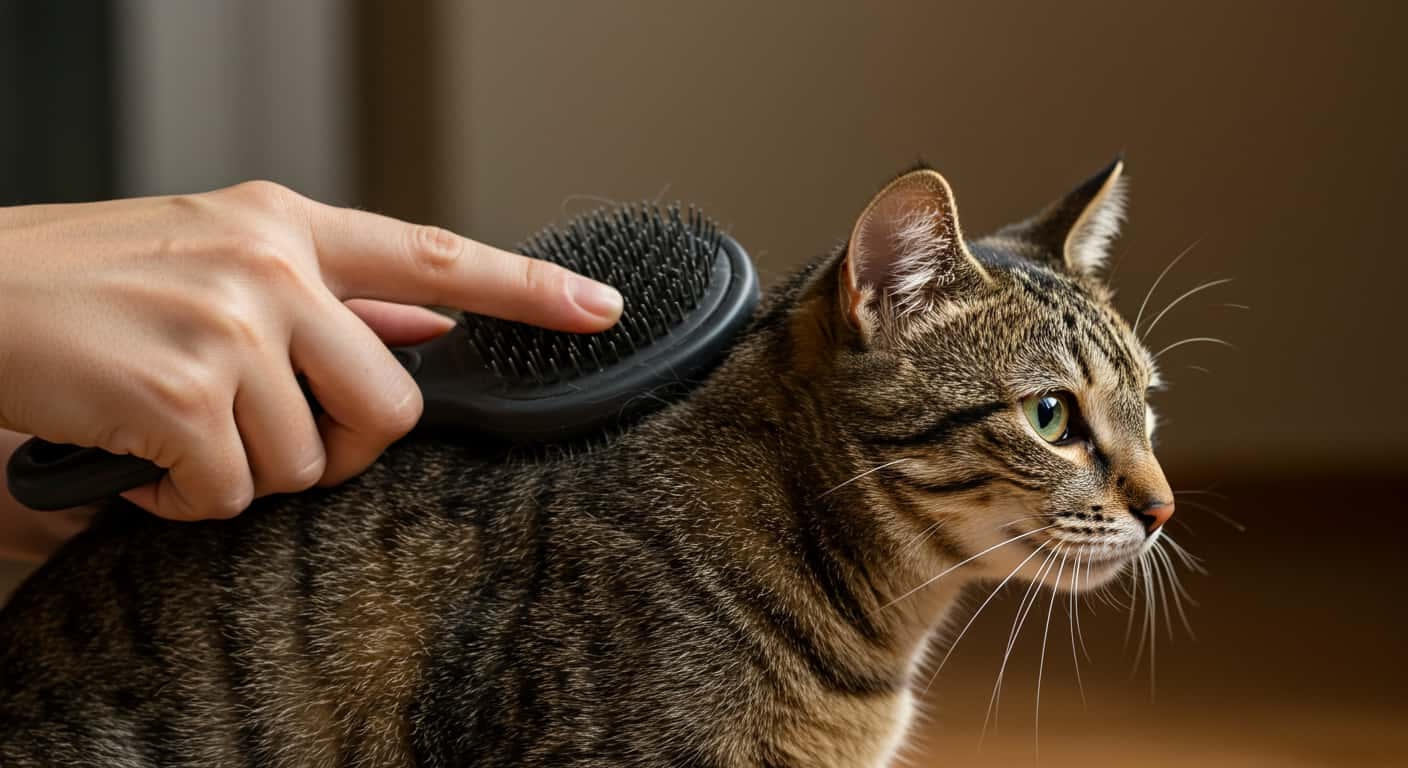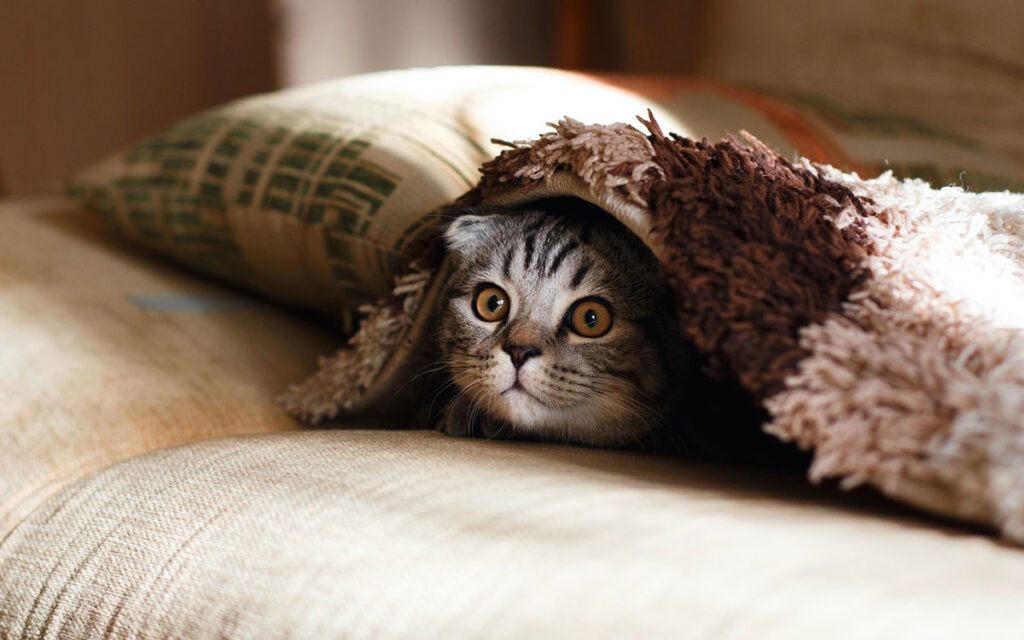Tabby cat grooming is more than just brushing or bathing, it’s how we keep our cats healthy, calm, and connected to us. Tabbies may be low-maintenance in some ways, but their coat types and personalities require the right approach to grooming.
This website was born in a house full of paws and personalities. My love for animals started with Mimi, my grandmother’s white cat who ruled the house. Today, it’s Luna, my shy grey tabby, who inspires every cat article here. She once ran from brushes but now leans into every stroke thanks to gentle routines and patience.
In this guide, you’ll learn how to groom your tabby cat with confidence. From shedding control to skin checks and product picks, we’ll cover it all, based on experience, research, and plenty of practice with real cats.
Table of Contents
Why Grooming Is Essential for Tabby Cats
Grooming supports coat health and comfort
Tabby cat grooming is important regardless of breed. While not all tabbies share the same lineage, most have one thing in common, a thick, multi-layered coat that needs regular care. Whether your tabby is short-haired or long-haired, grooming helps reduce shedding, prevent painful mats, and remove dirt, debris, or dead hair trapped in the coat.
Grooming gives you a chance to catch health issues early
Each time you groom your tabby, you’re checking for more than tangles. You can spot fleas, bumps, cuts, or dry patches early, before they become bigger problems. Regular grooming helps you notice changes in your cat’s body and behavior.
Luna once developed a tiny mat behind her ear. I only noticed it during our weekly grooming, and a quick trim saved her from a painful vet visit.
It also builds emotional connection
Grooming is one of the easiest ways to build trust with your cat. Tabbies are known for their sensitivity to touch and routine. If you make grooming calm and positive, it becomes a bonding ritual.
What started as a daily battle with Luna slowly turned into our quiet time together. The soft brush strokes, gentle voice, and consistency helped her relax. Now, she greets the brush with purrs instead of panic.
Best Grooming Tools for Tabby Cats
Why using the right tools matters
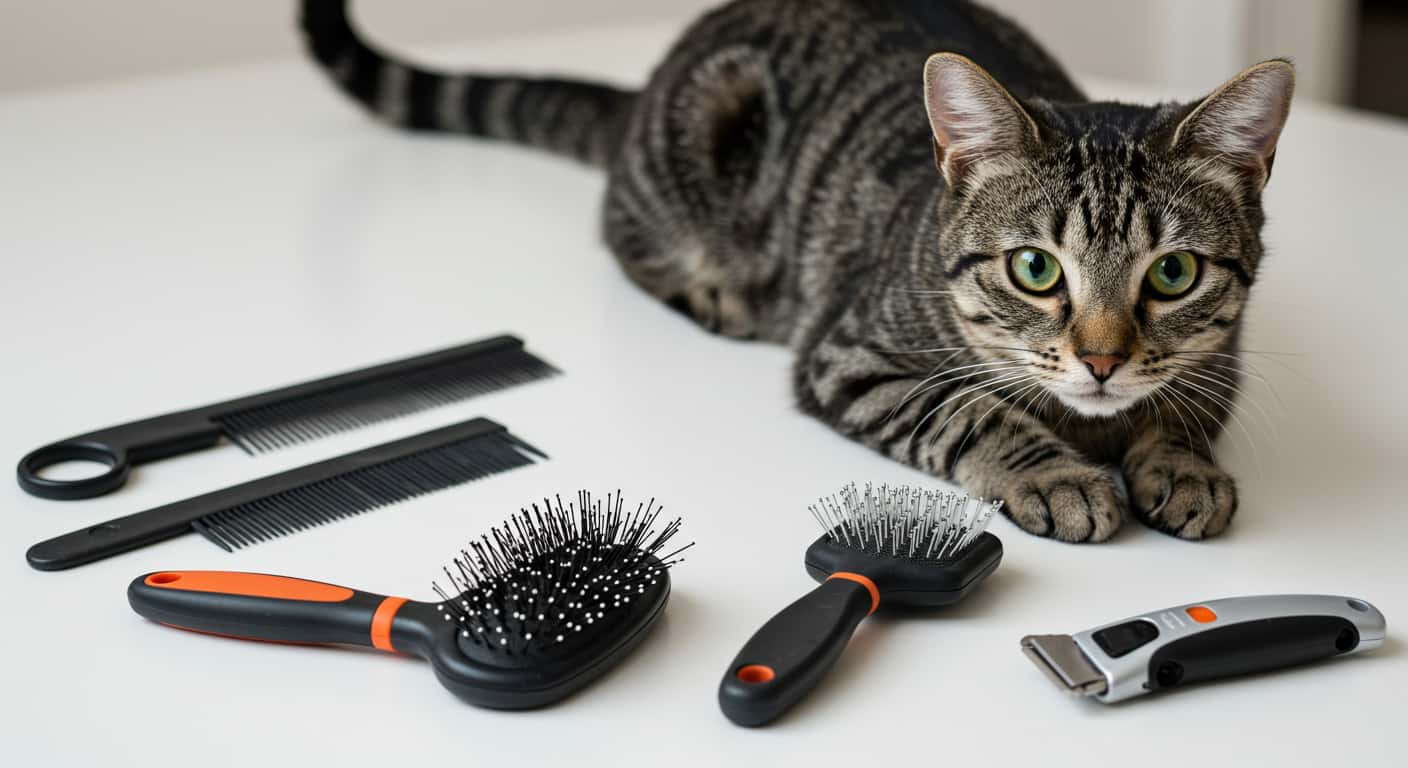
The success of tabby cat grooming depends largely on the tools you use. Using the wrong brush during tabby cat grooming can cause discomfort or make your cat avoid the process altogether. With the right tools, grooming becomes faster, safer, and more enjoyable for both of you.
Tabby cats can have short, medium, or long fur depending on their breed mix. A slicker brush is great for long-haired tabbies prone to mats, while a rubber grooming mitt works well for short-haired tabbies to remove loose hair and stimulate the skin.
Recommended brushes and combs for tabby cats
Here are some top tools to add to your tabby cat grooming kit:
| Tool Type | Best For | Coat Type |
|---|---|---|
| Slicker Brush | Detangling and de-shedding | Medium to long hair |
| Rubber Grooming Mitt | Daily hair removal and bonding | Short hair |
| Steel Comb | Finishing touch and deep brushing | All coat types |
| Nail Clippers | Safe trimming | All cats |
| Cat-safe Shampoo | Occasional bathing | Sensitive or itchy skin |
Make sure to avoid human clippers or harsh brushes. They can irritate your cat’s skin and make them resist future grooming sessions. Many cat owners find that using a grooming glove helps ease anxious cats into regular brushing.
| Tool | Best For | Pros | Cons |
|---|---|---|---|
| Slicker Brush | Long-haired tabbies, shedding season | Removes loose fur and minor tangles effectively | Can irritate skin if used too harshly |
| Grooming Glove | Short-haired tabbies, anxious cats | Feels like petting, reduces grooming stress | Less effective on mats or thick coats |
| Stainless Steel Comb | Daily brushing, detangling mats | Reaches deep undercoat, great for precision work | Needs patience and careful handling |
| Deshedding Tool | Heavy shedders, seasonal changes | Reduces undercoat bulk, minimizes hairballs | Can pull if used too roughly or too often |
| Mat Splitter | Severe tangles, long-haired cats | Breaks up mats without full shaving | Should be used carefully to avoid skin nicks |
| Nail Clippers | Regular paw care | Prevents snagging and overgrowth | Requires practice to avoid cutting the quick |
| Ear Cleaner Pads | Monthly grooming routine | Keeps ears clean and odor-free | Not all cats tolerate ear handling |
Tip to include below the table:
Choose tools based on your tabby’s coat type and temperament. You may only need a glove and comb for short-haired cats, while long-haired tabbies benefit from deshedders and mat splitters.
Luna’s favorite grooming tool
For Luna, the slicker brush was too much at first. I switched to a rubber mitt, and that made all the difference. It felt more like petting and less like grooming. Slowly, I introduced a comb to tackle light tangles, and now she tolerates both.
Finding the right tool is personal. Every cat reacts differently, so try one at a time and build from there. The smoother the experience, the easier it will be to make tabby cat grooming part of your weekly routine.
How to Brush Your Tabby Cat Step by Step
When and how often to brush a tabby cat
Brushing is a core part of tabby cat grooming. Most short-haired tabbies need brushing at least twice a week, while long-haired tabbies benefit from daily care. Regular brushing removes loose hair, prevents tangles, and helps reduce shedding around your home.
Pick a calm moment when your cat is relaxed. Start after meals or during quiet afternoon hours. Keep each session short in the beginning and gradually build it into your weekly routine. Tabbies love consistency and tend to respond well to gentle repetition.
Simple brushing steps for better results
Start by letting your tabby sniff the brush. Begin brushing around the cheeks and neck, which are less sensitive. Move slowly down the back, always following the direction of the fur. If you reach areas like the belly or tail, take your time and observe how your cat reacts. A metal comb works well behind the ears and under the legs, where light mats can form without you noticing.
Always finish with a treat and a soft voice. The more positive the experience, the easier it becomes to maintain consistent tabby cat grooming over time.
Pro Groomer Tip:
“Tabby cat coats vary, but consistency matters more than coat length. Even short-haired tabbies benefit from weekly brushing to minimize shedding and improve skin airflow.”
Hannah R., Certified Feline Grooming Specialist
Building trust through brushing
Luna, my grey tabby, hated grooming at first. She would hide the moment I picked up a brush. I switched to a rubber mitt, which felt more like petting than grooming, and everything changed. She stopped running, started purring, and now our brushing sessions are a peaceful ritual we both enjoy.
Tabby cats can be sensitive to touch, but with the right tools and patience, brushing turns into a shared moment of care. It supports skin health, lowers stress, and brings you closer together.
Bathing Your Tabby Cat Safely
Do tabby cats need baths?
In most cases, tabby cat grooming doesn’t require frequent bathing. Cats are excellent self-cleaners, and tabbies are no exception. However, there are times when a bath becomes necessary. If your cat has rolled in something sticky, has a skin condition, or has trouble grooming due to age or weight, a gentle bath can help.
Bathing is an occasional but helpful part of tabby cat grooming, especially when dealing with oily buildup or allergens that brushing alone might miss. Long-haired tabbies especially benefit from the occasional rinse to keep their coat light and free of tangles.
How to bathe a tabby cat without stress
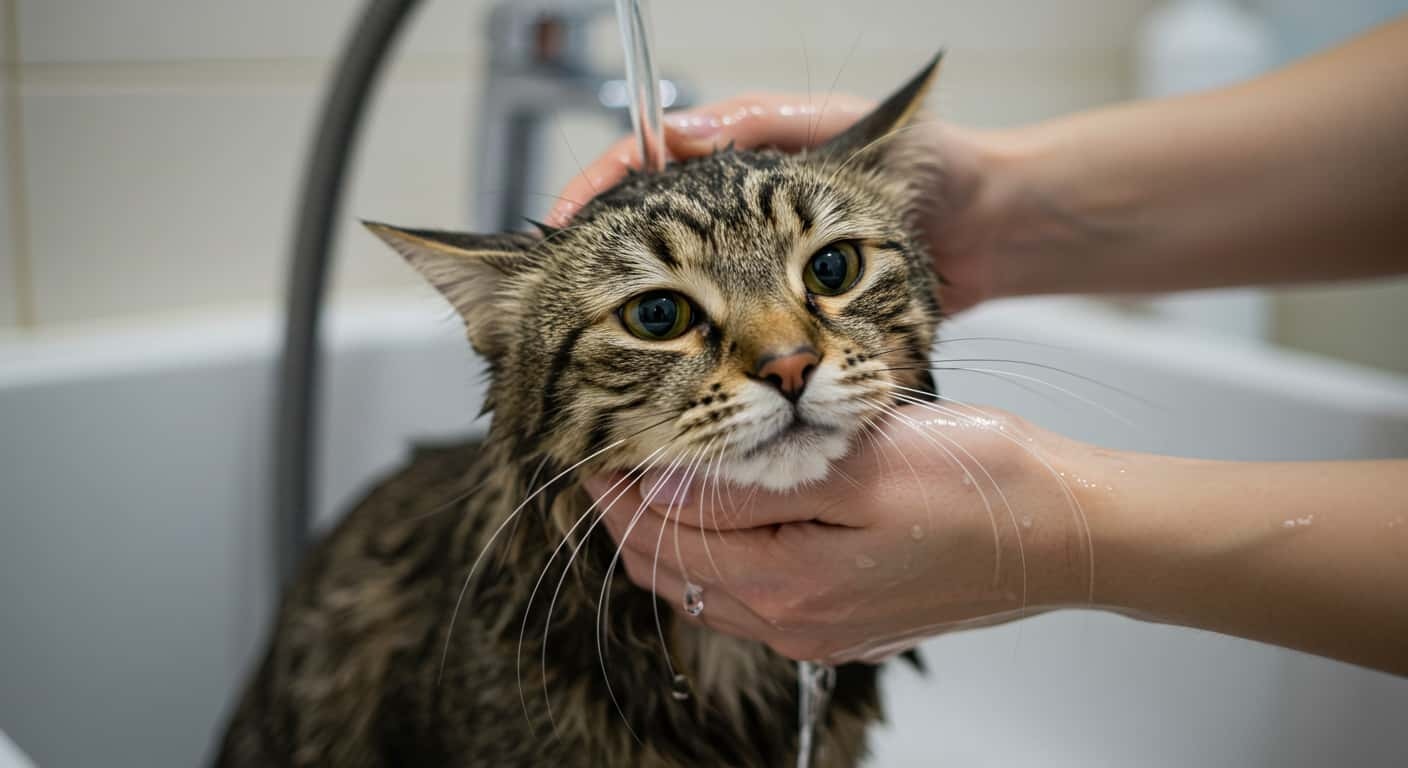
Start by trimming your cat’s nails and brushing their coat to remove loose hair. Prepare a shallow sink or tub with warm water and have everything ready before bringing your cat in. Use a cat-safe shampoo and rinse thoroughly to avoid skin irritation.
Hold your tabby gently but securely. Speak softly, move slowly, and avoid getting water in their ears or eyes. After the bath, wrap your cat in a warm towel and dry them off with gentle pats. Use a low-heat hairdryer only if your cat tolerates the noise.
Luna’s first bath experience
Luna was not a fan of water. The first time I tried, she bolted out of the tub before I even started rinsing. What worked was using a sink instead of a tub and adding a non-slip mat. I also switched to a mild oatmeal-based shampoo designed for sensitive skin. Now, she tolerates the occasional bath without fuss.
With the right preparation and patience, bathing becomes just another part of tabby cat grooming that supports your cat’s health and comfort. Even if it’s rare, it’s worth learning to do it gently and safely.
Seasonal Shedding and Hairball Control for Tabby Cats
Why tabby cats shed more in certain seasons
Seasonal shedding is a natural part of tabby cat grooming, especially during spring and fall. As temperatures shift, your cat’s coat adjusts, shedding its thicker winter undercoat or thinning out a summer coat. This is when brushing becomes even more important to reduce loose fur and keep your cat comfortable.
Short-haired tabbies may shed less visibly, but they still benefit from increased grooming during these periods. Long-haired tabbies tend to leave more fur around the house and are more prone to mats if not brushed frequently.
Tips to manage hairballs and excessive shedding
Hairballs are a common side effect of seasonal shedding. Cats ingest loose fur during self-grooming, which can lead to vomiting or digestive discomfort. Regular brushing helps cut down the amount of fur your tabby swallows.
Here are ways to manage hairballs during shedding season:
- Brush daily using a deshedding comb or slicker brush
- Offer hairball control treats or a vet-approved paste
- Add omega-3s to your cat’s diet to support skin and coat health
- Keep your cat hydrated to improve digestion
These steps are essential to keep tabby cat grooming stress-free during heavy shedding seasons.
“Regular grooming is more than a beauty routine, it’s an essential part of your cat’s health. For tabbies, brushing not only reduces shedding and mats but helps you catch skin issues before they escalate.”
Dr. L. Martinez, Small Animal Veterinarian
A seasonal approach to grooming
I noticed Luna sheds the most in early spring. To keep things under control, I increase brushing to once a day during peak shedding weeks. It not only keeps fur off the couch but also helps reduce the number of hairballs she deals with.
When tabby cat grooming becomes part of your seasonal routine, it feels less like a chore and more like a rhythm that matches your cat’s natural cycle. Keeping up with the seasons can make a big difference in your tabby’s comfort and overall health.
How to Groom a Cat That Hates It
Understanding grooming anxiety in tabby cats
Not every cat enjoys grooming, and tabbies can be especially expressive when they’re uncomfortable. If your cat runs, growls, scratches, or hides at the sight of a brush, it’s likely more about fear than fussiness. The key is to make tabby cat grooming feel safe, predictable, and positive.
Cats that dislike grooming may have had a bad experience or simply feel overstimulated. Rushing through a grooming session or using tools they’re not comfortable with can increase resistance over time.
Techniques for calming reluctant tabby cats
Start with your hands. In early tabby cat grooming sessions, mimic brushing with gentle petting motions. Once they’re calm, introduce a grooming glove, which feels more like petting than brushing. Gradually move toward short sessions with a soft brush, focusing on easy areas like the back and shoulders.
- Use treats and a calm voice before and after each session
- Keep sessions short and stop before your cat gets overwhelmed
- Groom when your cat is relaxed, not during play or high energy moments
- Try towel wrapping if your cat gets squirmy or tries to escape
Over time, your cat will associate grooming with quiet, positive moments, not stress.
How Luna overcame grooming resistance
Luna used to hide under the bed whenever I pulled out the brush. I learned to keep things light and low-pressure. We started with short glove sessions during her favorite nap time. Eventually, she began purring through brushing. It took patience, but now grooming is a time we both enjoy.
If your cat hates grooming, don’t force it. Go slow, offer rewards, and work on building trust. With consistency and the right approach, even reluctant cats can come around to regular tabby cat grooming.
Handling Mats, Skin Sensitivity, and Grooming Mistakes
How mats form in a tabby’s coat
Even with regular tabby cat grooming, mats can form in tricky spots like behind the ears, under the legs, or around the tail. These tangles are more than just uncomfortable, they can tug on the skin, cause pain, and even lead to infections if not removed.
Mats often show up in long-haired tabbies, especially during shedding seasons or if grooming lapses for a week or two. Areas that rub against bedding or collars are most at risk.
Safe ways to remove tangles and prevent skin issues
Never try to yank out a mat with a brush. Start by gently working through the edges with your fingers. Use a stainless-steel comb or a mat splitter if needed, and always go slow. For severe tangles, trimming with blunt-end scissors or seeing a groomer is safer.
Sensitive skin is another concern in tabby cat grooming. Some cats react to harsh shampoos, too much brushing, or low-quality grooming tools. Watch for redness, flaky patches, or sudden overgrooming.
To avoid irritation:
- Use hypoallergenic shampoos made for cats
- Brush gently with soft or flexible brushes
- Space out grooming sessions if your cat seems sore
Learning from past mistakes
When I first started grooming Luna, I used a slicker brush with metal bristles that scratched her skin. She avoided me for days. I switched to a softer glove-style mitt and gave her time to relax between sessions. Since then, her coat has stayed tangle-free and her trust has grown.
Mistakes happen, but they teach us how to be better caregivers. The goal of tabby cat grooming is not perfection, but consistency, comfort, and connection.
Is It Safe to Shave a Tabby Cat?
When shaving is actually needed
Shaving is not a routine part of tabby cat grooming, but there are cases where it can help. If your cat develops thick mats that can’t be removed with brushing or combing, a light shave may prevent skin irritation and discomfort. Shaving might also be recommended for older cats who can’t groom themselves or for medical reasons like skin treatment.
Even then, it should only be done by a professional groomer or veterinarian.
Why full shaving should be avoided
A cat’s coat helps regulate body temperature, protect the skin, and reduce stress. Shaving it all off can disrupt this balance. Tabbies in particular may become anxious or overgroom when their fur is suddenly removed. That’s why shaving should be a last resort, not a go-to method for coat care.
Instead of shaving, build a better routine. Brushing more often and using a detangling spray are much safer, long-term options.
Luna’s close call with the clippers
Luna once had a stubborn mat near her hind leg. At first, I thought shaving was the only answer. But I tried daily brushing, added a detangler, and gave her space between sessions. Within a few days, the mat was gone.
That moment taught me how important consistency is in tabby cat grooming. The more you stick to a routine, the less likely you’ll ever need to shave.
Long-Term Grooming Success and Weekly Routine
Building a routine that works for both of you
The key to effective tabby cat grooming isn’t doing everything at once, it’s doing small things regularly. When grooming becomes part of your cat’s weekly rhythm, it creates calm, strengthens your bond, and helps catch problems before they grow.
Your weekly schedule can be simple:
- 2 to 3 brushing sessions for short-haired tabbies
- 4 to 5 sessions for long-haired tabbies
- Monthly nail trims and ear checks
- Occasional baths only when needed
- Quick daily checks for mats or shedding
Having a checklist or setting reminders can help you stay consistent, especially during seasonal changes when cats shed more than usual.
Grooming isn’t just about coat care, it’s also about understanding your cat’s temperament. If you’re curious about what makes tabbies so emotionally unique, learn more about the tabby cat personality here.
Reinforcing good habits with the right environment
Pick a quiet spot and a regular time of day. Use a soft tone, gentle hands, and a familiar brush. If your cat gets nervous, shorten the session. It’s better to have short, positive grooming sessions than long ones your cat dreads.
Keep your tools clean and store them in one spot. Luna now recognizes the drawer where her grooming kit lives. When she sees it, she actually walks over and waits. That didn’t happen overnight, but it came from routine, not force.
Why long-term care matters
Without a plan, grooming becomes a chore. But with routine, it becomes care. Regular tabby cat grooming helps reduce vet visits, prevents painful tangles, and supports your cat’s comfort. It’s a simple act that speaks volumes.
What started as a struggle with Luna turned into something we both enjoy. Grooming her each week reminds me how even a few minutes of calm touch can deepen trust and keep her happy.
Bonus: Weekly Tabby Cat Grooming Tracker (Downloadable)
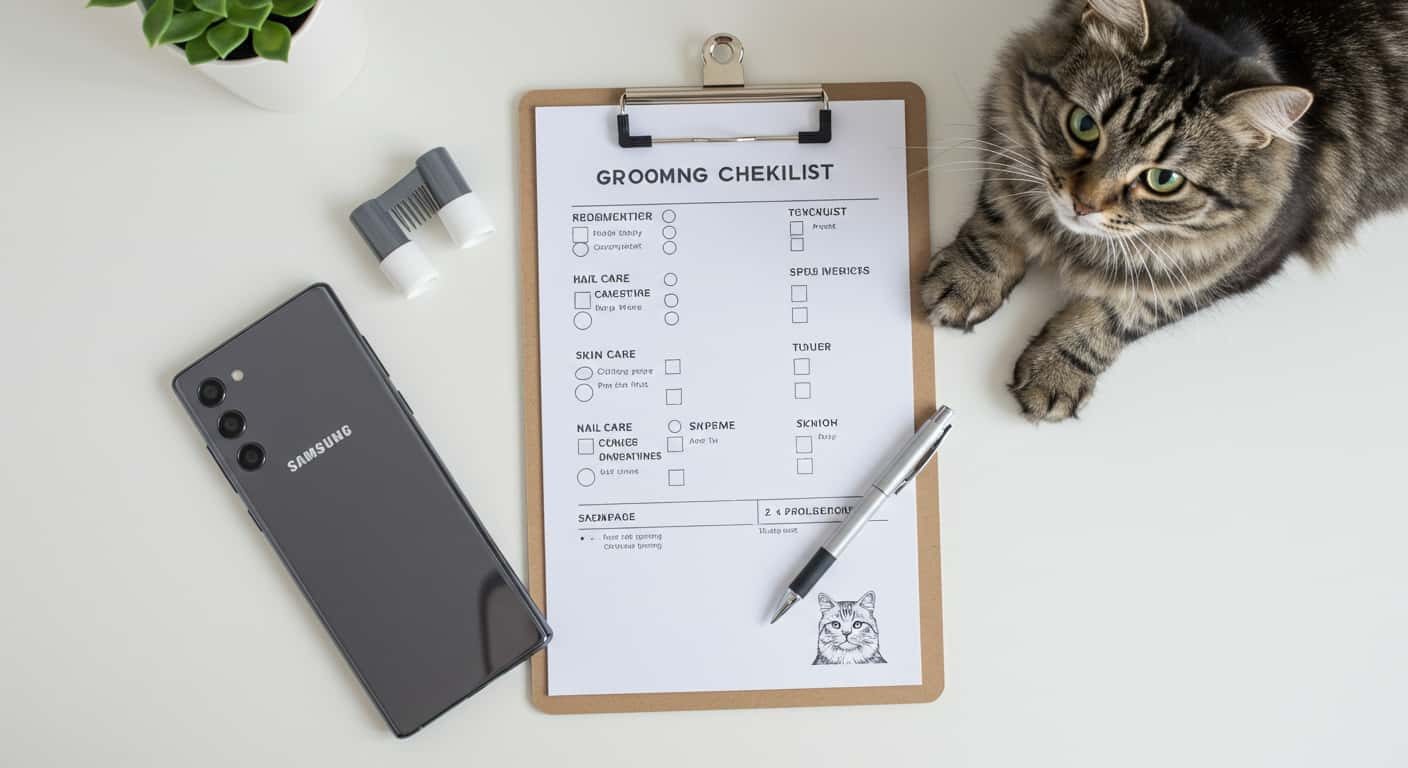
Consistency is key when it comes to tabby cat grooming, and many cat parents find it helpful to track progress. That’s why we’ve created a free grooming checklist you can print or save.
This tracker helps you stay on top of:
- Weekly brushing sessions
- Nail trims
- Ear cleaning
- Coat checks for mats or tangles
- Monthly baths (if needed)
- Shedding season care
Use this tracker to simplify your weekly tabby cat grooming process and never miss a session.
Download the Tabby Grooming Tracker (PDF)
Hang it on the fridge or keep it with your grooming tools. It’s a simple way to keep your cat’s coat healthy and make grooming part of your routine.
Using a tracker is especially helpful for multi-cat households or for tabbies that need extra care due to age or long hair. It also keeps pet sitters or family members in sync.
Frequently Asked Questions About Tabby Cat Grooming
Do tabby cats need grooming?
Yes. All cats benefit from regular grooming, including tabbies. Brushing helps remove loose hair, prevents mats, and reduces hairballs.
How often should you bathe a tabby cat?
Only when necessary. Most tabbies rarely need baths unless they get into something messy or have a skin condition.
Why does my tabby cat lick me?
Licking is often a sign of affection. It’s a grooming behavior cats use to bond with others, including their humans.
Is it okay to shave a tabby cat?
Shaving should be avoided unless medically required. It’s best to manage mats or thick coats with regular brushing and trimming.
How do you groom a cat that hates it?
Start slow, use gentle tools like grooming gloves, and reward with treats. Keep sessions short and build trust over time.
What are the benefits of grooming for cats?
Grooming supports healthy skin, reduces shedding, minimizes hairballs, and strengthens the bond between you and your pet.
Still unsure how to start? Our full tabby cat grooming guide above covers brushing, bathing, and handling tricky behaviors step-by-step.
Conclusion
Grooming isn’t just about looks, it’s about care, connection, and keeping your tabby comfortable and healthy for the long haul. When done gently and consistently, grooming becomes something your cat can enjoy rather than fear.
From brushing to trimming, bathing to seasonal shedding, each step you take builds trust and makes a real difference in your cat’s well-being. Luna reminded me of that every time we turned a once-stressful routine into a quiet bonding moment.
If you’re just starting out, take it slow. With the right tools and a little patience, you’ll find your rhythm. And if you ever need more tips or support, you’re not alone. This entire site was built to help cat lovers like you navigate it all, one purr at a time.
Whether you’re dealing with a kitten or senior, making tabby cat grooming a habit will pay off in your cat’s comfort and health.
For more tabby care advice, don’t miss our guide on everything you need to know about tabby cats.

